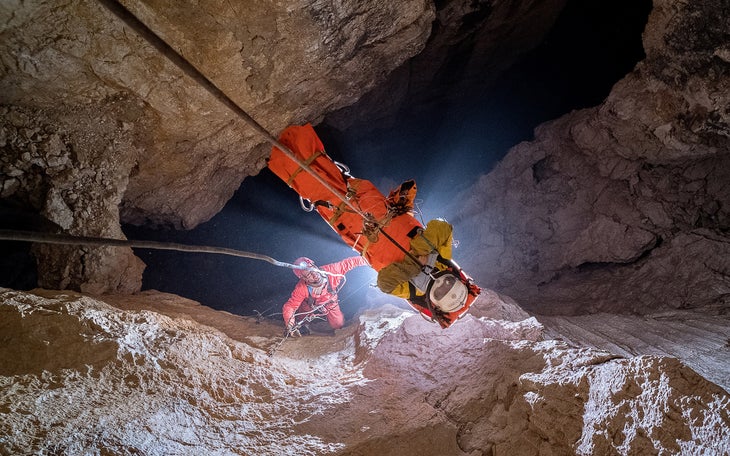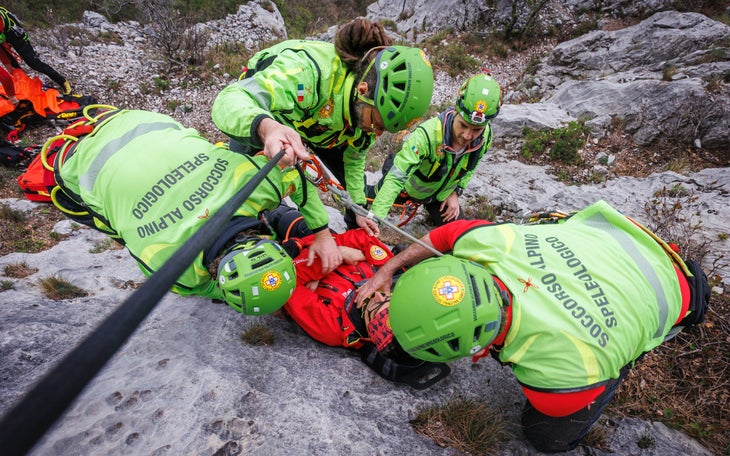Italy’s picturesque mountains have experienced an upturn in tourism this year, and with it, a staggering increase in fatal accidents.
Roberto Bolza, the vice president of Italy’s national rescue organization, Corpo Nazionale Soccorso Alpino e Speleologico (CNSAS), told Outside that more than 100 people have died in the country’s peaks since June 1—a shocking average of three deaths per-day.
“It’s a dramatic figure,” Bolza said.
Bolza said that the uptick in deadly falls and accidents is part of a growing trend that the CNSAS—which was founded in 1954—has experienced over the past decade.
“Over the past ten years, the Soccorso Alpino has carried out as many rescue operations as in the first 60 years of its history,” he said.
Deaths and Rescues Across the Alps
Most of the incidents have involved hikers, he said, and are similar to others CNSAS sees during a typical year: slips and falls on challenging terrain, sudden illness or cardiac arrest, rock climbing accidents, and situations caused by rapidly changing weather or a lack of proper clothing.
In some of the deaths, overconfident tourists have ventured off-trail, or gotten lost in steep, technical terrain, without proper experience or equipment.
“Too many are treating serious alpine trails with the same casual mindset they’d bring to a stroll in the park,” Maurizio Dellantonio, the head of CNSAS, told the Italian newspaper Corriere della Sera in July.
Lifesaving missions are up 20 percent compared to 2024, Dellantonio said. One CNSAS rescue involved a 30-year-old hiker who attempted to ascend a 12,000-foot peak wearing tennis shoes. He called for aid after becoming stuck on the peak during the night. In another incident, two Korean hikers in their sixties embarked on a via ferrata—a climbing route with fixed cables and iron steps that requires users to don climbing gear—without harnesses or helmets. All three lived.
But others have not been so lucky. On July 24, a 15-year-old French boy, Liam Rezac, died after he became lost on a hiking trail and then slipped and fell in the Val D’Aosta region. Also in July, a 21-year-old hiker named Gioele Fortina died after slipping and falling from a trail in Piedmont.
In late July, A 60-year-old hiker died after losing his balance and falling off a trail in the Fassa Valley, deep in the Dolomites. A few days later, an 80-year-old died in a similar accident on the same trail.
Holistic statistics for 2025 are not yet available, but per CNSAS statistics from 2024, the most common deaths in the mountains involve Italian men between the ages of 50 and 60. This demographic is also responsible for 16 percent of all rescue calls.
Why the Uptick?
Some experts point the uptick in disasters to climate change—melting ice and permafrost increases rockfall on the peaks, and leads to the occasional collapse of glaciers. In 2022, 11 people died when a massive serac on the Marmolada Glacier disintegrated, showering a group of hikers with ice and rock.
But Bolza believes the warming conditions are contributing in a different manner.
It’s so hot in Italy’s lowlands, he said, that “more and more people are going to the mountains.” According to The Guardian, Italian newspapers have throughout the summer repeatedly run images of overcrowding at popular hiking destinations and at cable cars in the Alps.

Bolza said that other societal dynamics are enticing people to the peaks. “It is driven in part by the influence of social media and the growing promotion of outdoor activities,” he added.
Mountain guides and rescuers who spoke with Outside also blamed the post-COVID popularity of outdoor recreation in the country. The surge, they said, has resulted in jam-packed trails, and inexperienced hikers venturing into dangerous terrain.
“After the coronavirus pandemic, we had a really big increase of people visiting,” said Italian IMFGA mountain guide Luca Vallata. “Many people without the necessary experience have started to enter the mountains.”
Guides told Outside that rock climbing has exploded in popularity in the last decade, aided by an influx of commercial climbing gyms, the exposure of the Olympics, and the success of documentary films. Vallata said that these new climbers have experience in indoor gyms but don’t have the experience to tackle challenging routes on peaks.
“It’s a combination of more and more people who have little experience all visiting the mountains at the same time,” said Simon Geitl, an Italian alpinist.
A Reliance on Tech
Overcrowding and a lack of preparedness in the wilderness isn’t a new issue. Guides told Outside that hikers’ reliance on technology for route finding and adventure advice is also getting people into trouble. Vallata said he’s heard of incidents in which hikers use artificial intelligence to help them discover a route, only to discover that the trail is not safe.
“Since about one year ago, many people have begun to think everything on ChatGPT is correct,” Vallata said. “It is not a tool for mountain advice, for routes, or for planning.”

Geitl said that the reliance on technology can distract people from the dangers along the trail. “Many people on hiking trails are too often distracted by their cell phones, and are not aware of the danger that a misstep can have,” he said.
“There is of course a lot of good and accurate information on the Internet,” Geitl said, “but unfortunately there are also many false or inaccurate sources that people trust, and suddenly find themselves in an awkward situation where they don’t know what to do next, and often all they can do is call rescue.”
The Importance of Good Intel
Both Geitl and Vallata recommended that visitors to the peaks hire a guide.
“If you go with a guide, you are more safe,” Vallata said. “I am a guide, so maybe I am biased, but even if you don’t use a guide, the most important thing is to not trust only information you find online.”

Vallata said that his international clients often arrive underprepared for conditions in the Alps, where rain, sleet, and snow can fall during all months of the year. He emphasized that it’s important to recognize that weather in the mountains can change dramatically.
“Sometimes we meet in the morning, and my clients have only a t-shirt and shorts, and a pair of trainers,” he said. “They see that at the moment, the weather is super nice, and it is warm, but they don’t realize conditions can change super quickly.”
Negligence Has Consequences
The CNSAS does charge for rescues, based on a tiered payment structure that takes into account location and severity of the operation. Dellantino said that half of all those rescued refuse to pay. Some American search and rescue organizations, many of which are also seeing a dramatic surge in distress calls this summer, have also asked for similar fines to be levied on negligent hikers.
On July 31, a British hiker called for rescue from a closed trail in the Dolomites. CNSAS crews were able to locate the man and pluck him from a mountainside with a helicopter.
Authorities later determined that the hiker had ignored repeated signs warning of dangers and then ventured onto a closed trail. Local health authorities issued the man $16,000 in fines. The incident generated global headlines.
Bolza, the CNSAS vice president, said that his organization “continues to recommend the utmost caution, careful planning of outings, the use of appropriate equipment, and the constant monitoring of weather forecasts before undertaking any high-altitude activity.”


